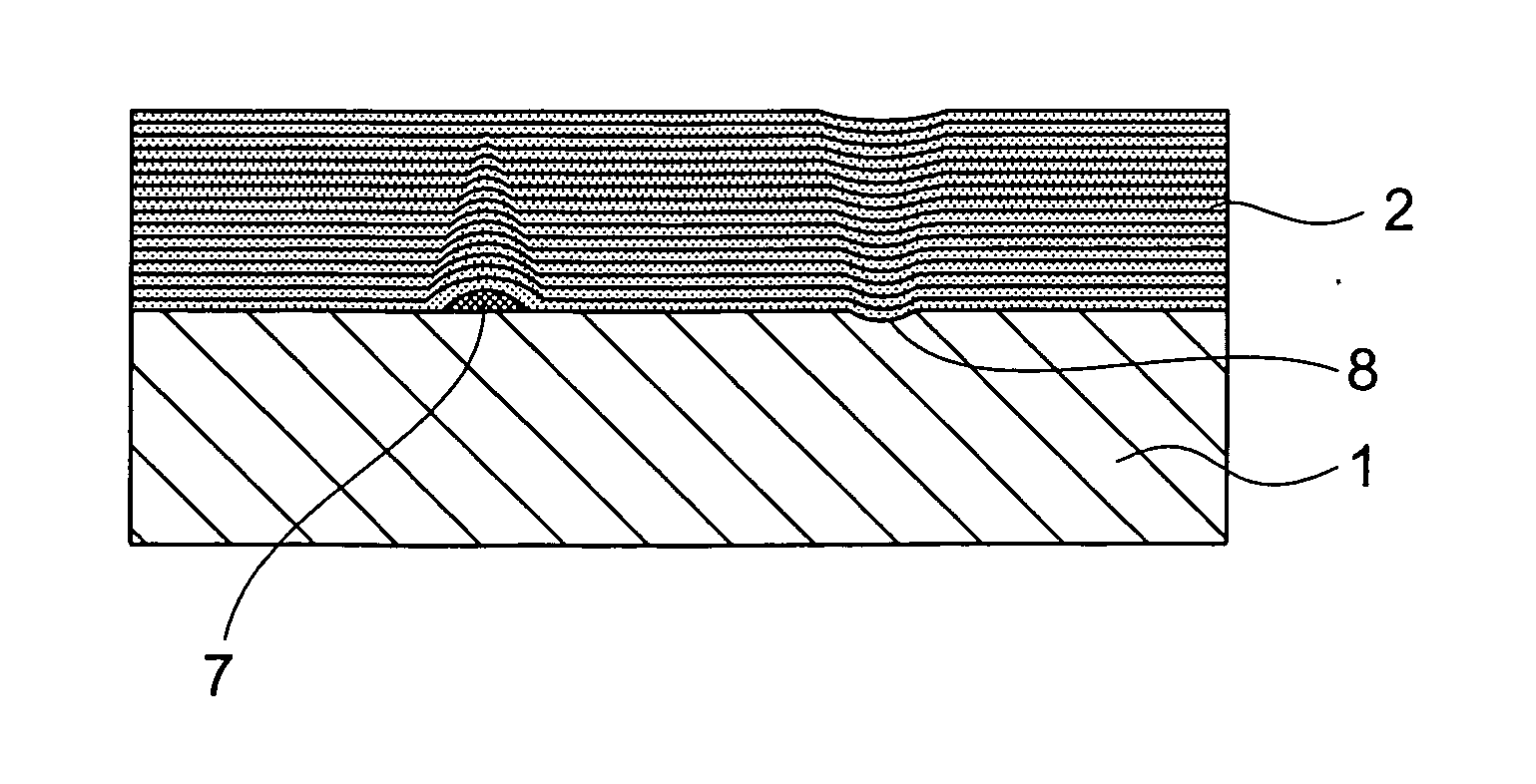Multilayer reflective film coated substrate, manufacturing method thereof, reflective mask blank, and reflective mask
- Summary
- Abstract
- Description
- Claims
- Application Information
AI Technical Summary
Benefits of technology
Problems solved by technology
Method used
Image
Examples
example 1
[0107] As a substrate, a low thermal expansion SiO2—TiO2-based glass substrate having a 152 mm square shape with a thickness of 6.35 mm was prepared. This glass substrate had a smooth surface of 0.15 nmRms and a flatness of 100 nm or less by mechanical polishing and cleaning.
[0108] Surface defects (convex and concave defects) on the surface of the obtained glass substrate were measured by the use of a defect inspection apparatus (MAGICS M-1350 manufactured by Lasertec Corporation). It was found that several hundreds of convex and concave defects were present over the entire substrate.
[0109] Then, a multilayer under film comprised of Mo / Si alternately-layered films was formed on the substrate. The film formation was carried out by the use of an ion beam sputtering apparatus. At first, the angle of the substrate in the apparatus was adjusted so that sputtered particles from a target were incident on the substrate from a direction inclined by 60° with respect to the perpendicular dir...
example 2
[0117] A multilayer reflective film coated substrate was produced in the same manner as in Example 1 except that a multilayer under film was formed such that the cycle length was 14.0 nm, ΓMo was 0.431, the number of cycles was 20, and the thickness was 280 nm, an intermediate layer was formed to a thickness of 14.0 nm, and a Si film and a RuNb film were formed to thicknesses of 4.0 nm and 2.5 nm, respectively, as a capping layer on the multilayer reflective film.
[0118] In this multilayer reflective film coated substrate, the relationship of the formula (1) can be satisfied when n=2 and the relationship of the formula (2) can be satisfied when m=2.
[0119] The reflectance of the multilayer reflective film of the multilayer reflective film coated substrate thus obtained was measured by applying EUV light of 13.5 nm at an incident angle of 6.0° and it was 64.7%.
[0120] Further, surface defects (convex and concave defects) of the multilayer reflective film were measured by the foregoin...
example 3
[0127] A buffer film made of chromium nitride (CrN: N=10 at %) was formed on the capping layer of the multilayer reflective film of the multilayer reflective film coated substrate obtained in Example 1. The film formation was carried out by the use of a DC magnetron sputtering apparatus and the thickness was set to 20 nm.
[0128] Then, a film containing Ta as a main component and further containing B and N was formed on the buffer film as an absorber film with respect to exposure light having a wavelength of 13 to 14 nm. The film formation was carried out in a DC magnetron sputtering apparatus using a target containing Ta and B and adding nitrogen in an amount of 10 vol % to argon. The thickness was set to 70 nm as a thickness that can sufficiently absorb the exposure light. The composition ratio of the formed TaBN film was such that Ta was 0.8, B was 0.1, and N was 0.1.
[0129] In the manner as described above, a reflective mask blank was produced.
[0130] Then, the absorber film of t...
PUM
| Property | Measurement | Unit |
|---|---|---|
| Thickness | aaaaa | aaaaa |
Abstract
Description
Claims
Application Information
 Login to View More
Login to View More - R&D
- Intellectual Property
- Life Sciences
- Materials
- Tech Scout
- Unparalleled Data Quality
- Higher Quality Content
- 60% Fewer Hallucinations
Browse by: Latest US Patents, China's latest patents, Technical Efficacy Thesaurus, Application Domain, Technology Topic, Popular Technical Reports.
© 2025 PatSnap. All rights reserved.Legal|Privacy policy|Modern Slavery Act Transparency Statement|Sitemap|About US| Contact US: help@patsnap.com



